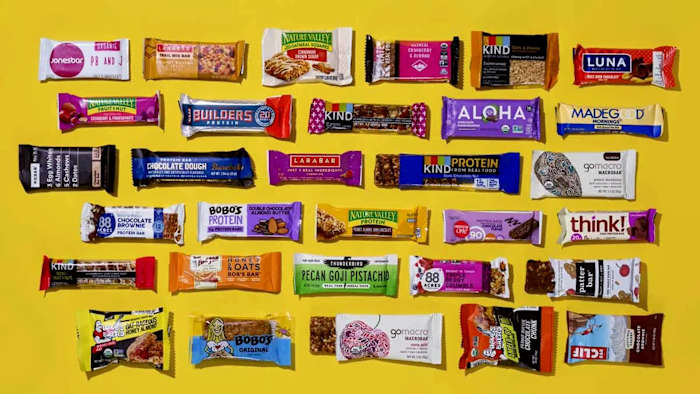
Energy bars have evolved significantly since their rise in popularity in the 1980s. Initially targeted as workout supplements for athletes, early brands such as Clif Bar and PowerBar were soon joined by Atkins and ZonePerfect bars, which aimed to assist with weight management. Today, they have transcended their niche market and can be found almost anywhere, from gym and health food stores to gas stations, supermarkets, and drugstores. It is not uncommon to have a bar on hand in your kitchen, office, or bag. According to Mintel, about 40 percent of individuals consume energy bars a few times a week.
Despite their seemingly healthy appearance, many energy bars may not provide the benefits they claim to offer. Even those labeled as “high in protein” could essentially be equivalent to candy bars, as stated by Natalie Allen, RD, a clinical associate professor of nutrition and team dietitian at Missouri State University. With numerous options available, it can be challenging to discern which bars will genuinely provide a nutritious energy boost while also tasting good. To aid consumers in making informed choices, Consumer Reports conducted tests on 31 popular bars to evaluate their nutritional value and flavor, allowing shoppers to make better decisions when selecting bars.
What Gives You Energy, Anyway?
These bars do not contain any extraordinary ingredient that directly boosts energy levels. This is because energy, in a dietary context, primarily refers to the calories present in a food or beverage that provide fuel for the body. According to Leslie Bonci, RD, MPH, a sports dietitian with experience working with various sports teams and organizations, calories can be derived from carbohydrates, protein, or fat.
Your body breaks down carbs faster than protein or fat. All carbs are converted to glucose, a sugar that enters the bloodstream and is used by cells for energy, Bonci says. Simple carbs, such as sugar and white flour, are broken down fastest of all. That can be helpful if you’re doing an extremely demanding activity, like running a marathon, because that can deplete your cells’ existing glucose. Eating a quickly digested carb can replenish it, giving you the push you need to keep going.
Most people don’t need that kind of energy rush on a normal day. Simple carbs can make your blood sugar level rise rapidly. But it falls just as quickly because your body pumps out insulin to sweep the glucose into cells. This sugar crash can leave you feeling tired and hungry, Allen says.
What you really need most of the time is the sustained energy that comes from carbs combined with fiber, protein, and fat, she says. Those slow the release of glucose into the bloodstream and keep blood sugar levels steadier, she says.
The Good Stuff in These Bars
Many bars serve up a combination of carbs, fiber, protein, and fat, but not all of them use wholesome ingredients to get there. For the healthiest picks, look for bars made mostly from unprocessed foods, such as whole grains, nuts, seeds, and dried fruit, says Amy Keating, RD, the CR dietitian who oversaw our testing. Those ingredients are usually more nutrient-packed than their processed counterparts, such as protein powders and added sugars (see “Ingredients to Avoid” for more on those).
If you’re buying a grain-based bar, check that it’s made with whole grains, such as oats or quinoa. “Whole grains are an excellent base,” Allen says. “They contain carbs and fiber, which keep blood sugar levels steady and help you feel full for longer.” Whole grains also reduce inflammation and harmful LDL cholesterol, which protects the heart. Getting at least three servings a day may reduce the risk of heart disease by 22 percent, according to a 2016 BMJ study.
But most Americans don’t eat that many whole grains. If you’re among them, consider an energy bar like the Kind Healthy Grains Oats & Honey bar. It has 20 grams of whole grains per bar, which counts as about one serving.
Many energy bars contain nuts, nut butters, and seeds. Don’t worry about their fat and calorie content. Research shows that eating these foods regularly prevents weight gain and may even help you shed some pounds. The protein, fiber, and fat in nuts and seeds can fend off hunger. Plus, fat adds flavor. “Without it, biting into an energy bar can feel like eating the bottom of a running shoe,” Bonci says.
What’s more, each nut and seed contains different vitamins and minerals. For example, almonds supply potassium and iron, an energy-boosting mineral, and they’re a big part of many of the bars in our tests, including Larabar Cherry Pie and Patterbar Clean Energy Fruit + Nut + Seed. And walnuts, hemp, and chia seeds are some of the few plant-based sources of omega-3 fatty acids, healthy fats tied to heart and brain health.
To sweeten their flavor, many bars include dried fruits like dates and cherries. Although dried fruits are high in sugar, they naturally contain fiber, vitamins, and antioxidants, Allen says. That makes them a healthier sweetener than added sugars.
With all of those good-for-you ingredients, should you make energy bars part of your daily routine? It’s perfectly okay if you enjoy snacking on them and the one you choose doesn’t add a lot of extra calories to your day. Energy bars can also work as an occasional meal, and if you have to choose between a healthy bar and nothing, the bar is better. But you can eat most bars in a few quick bites, so they may not be as satiating as something that takes longer to eat. For instance, you’ll probably feel more satisfied after a bowl of oatmeal topped with fresh fruit and nuts than you would after eating a bar.
Ingredients to Avoid
Not all bars are created equal. Look out for the following:
Too many calories: Even the healthiest bars can pack in a lot of calories. Those in our tests ranged from 90 to 340 calories, but some others clock in at 400 calories or more. If you’re eating the bar as a meal or exercising a lot, you may need a bar with 200 to 400 calories, Allen says. If you’re not, the extra calories can lead to weight gain.
Added sugar: The American Heart Association says 25 grams is the daily added sugar threshold for women; 36 grams for men. Too much added sugar raises the risk of weight gain, type 2 diabetes, and heart disease. The bars we tested ranged from 0 to 17 grams of added sugars. Keating suggests choosing a bar with no more than 7 grams. Natural sources of added sugars, such as concentrated fruit juices and honey, aren’t much better than sugar and syrups. “They may contain some nutrients, but they still count as added sugar,” Keating says.
On the flip side, take a second glance at bars with zero added sugar. Some of them are smart choices because they get their sweetness from dried fruit, but others use artificial sweeteners. Although scientists are still studying the effects of sugar substitutes, many are linked to health problems, such as cardiovascular disease.
Processed protein: When it comes to protein, many assume that the more in a bar, the better for building muscle and losing weight. But that’s not always the case. It’s important to know where that protein comes from. Bars with a lot of protein (such as Clif Builders Chocolate Protein Bar, with 20 grams) are typically pumped up with processed protein, like soy or pea powders. Often called isolates or concentrates, these proteins are extracted from their original food, so they don’t contain other nutrients, Keating says. If a protein powder is the first or second ingredient in a bar’s ingredients list, that’s where much of the bar’s protein comes from.
Bars made with whole foods, such as eggs, nuts, or seeds, won’t have as much protein, and that’s okay. The daily recommendation is 0.36 gram per pound of body weight, and most people easily get that in their regular diet. Plus, even lower-protein bars may contain a considerable amount. For instance, most of the whole-food-based protein bars in our tests had 9 to 12 grams of protein. That’s 17 to 22 percent of the daily protein needs of a 150-pound person.
Processed fiber: Most Americans don’t get the recommended 28 grams of fiber each day. But it’s better to get your fiber from whole grains, nuts, and fruits than processed fibers like chicory root or inulin (a plant extract) found in some energy bars. Those don’t provide the same benefits as the fiber in foods because they don’t contain other vitamins and minerals, Keating says. Plus, if you’re not accustomed to large amounts of fiber, eating a fiber-rich bar—such as the 11 grams in Bobo’s Double Chocolate Almond Butter Protein Bar, which contains processed tapioca and chicory root fibers—may cause bloating and stomachaches.
Best & Worst Energy Bars
To make it easier for our testers to compare the bars fairly, we grouped them into three categories based on the ingredients they focus on: The categories were fruit and nuts or seeds; whole grains; and protein. (None of these categories is better than another. There are healthy and not-so-good options in each.) They’re ranked here by nutrition score, followed by taste. Higher nutrition scores went to those bars with more whole-food ingredients and lower amounts of added sugars, sodium, and saturated fat. Those with the same scores are listed alphabetically. Recommended bars scored at least 4 (out of 5) for nutrition and taste and had no processed protein or fiber. The nutritional information provided here is for a single bar.
Fruit & Nut or Seed Bars
With ingredients like almonds, pumpkin seeds, and fruits, these bars can have a satisfying, sometimes crunchy, “real food” texture.
Copyright 2025 by WKMG ClickOrlando – All rights reserved.

















